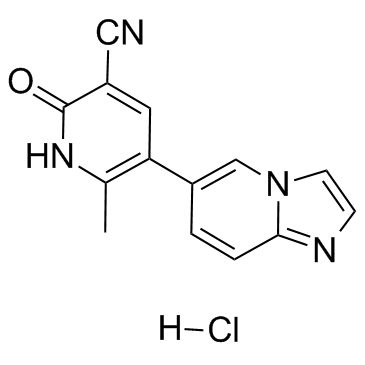119615-63-3
| Name | 5-imidazo[1,2-a]pyridin-6-yl-6-methyl-2-oxo-1H-pyridine-3-carbonitrile,hydrochloride |
|---|---|
| Synonyms |
E 1020
pyridin-6-yl-6-methyl-2-oxo-3-pyridinecarbonitrile hydrochloride Olprinone hydrochloride Olprinone (Hydrochloride) 1,2-dihydro-5-imidazo<1,2-a>pyridin-6-yl-6-methyl-2-oxo-3-pyridine carbonitrile hydrochloride 1,2-dihydro-6-methyl-2-oxo-5-(imidazo[1,2-a]pyridin-6-yl)-3-pyridine carbonitrile hydrochloride MFCD01749474 Loprinone hydrochloride |
| Description | Olprinone Hcl(Loprinone Hcl) is a selective phosphodiesterase 3 (PDE3) inhibitor. IC50 value:Target: PDE3Olprinone is used as cardiotonic agent with positive inotropic and vasodilating effects. Olprinone has been reported to improve microcirculation and attenuate inflammation. Olprinone is often used to increase cardiac output after cardiopulmonary bypass (CPB). Olprinone was infused at a rate of 0.2 μg/kg/min when weaning from CPB was started. Olprinone has also shown potent antioxidative and anti-inflammatory effects in the meconium-induced oxidative lung injury. |
|---|---|
| Related Catalog | |
| References |
| Density | 1.34g/cm3 |
|---|---|
| Melting Point | >300ºC |
| Molecular Formula | C14H11ClN4O |
| Molecular Weight | 286.72 |
| PSA | 83.18000 |
| LogP | 2.60738 |
| Storage condition | 2-8℃ |
CHEMICAL IDENTIFICATION
HEALTH HAZARD DATAACUTE TOXICITY DATA
MUTATION DATA
|
| Symbol |

GHS07 |
|---|---|
| Signal Word | Warning |
| Hazard Statements | H315-H319-H335 |
| Precautionary Statements | P261-P305 + P351 + P338 |
| Personal Protective Equipment | dust mask type N95 (US);Eyeshields;Gloves |
| Hazard Codes | Xi: Irritant; |
| Risk Phrases | R36/37/38 |
| Safety Phrases | S26 |
| RIDADR | NONH for all modes of transport |
| RTECS | US4201450 |
